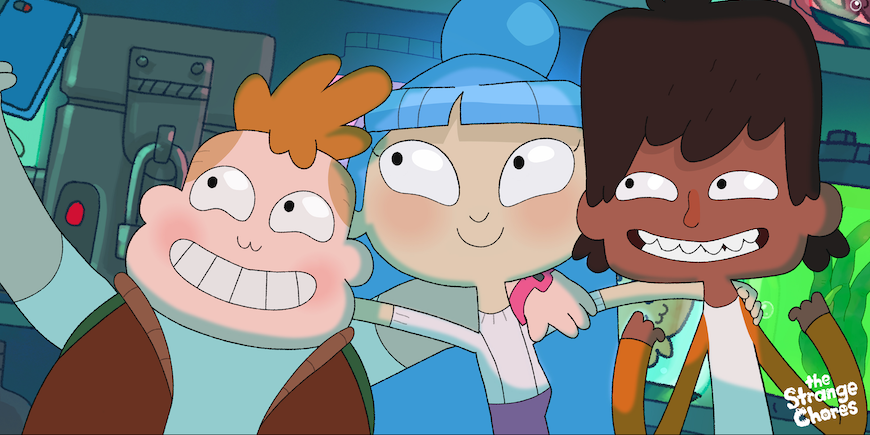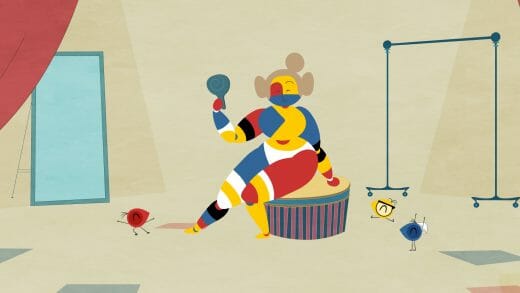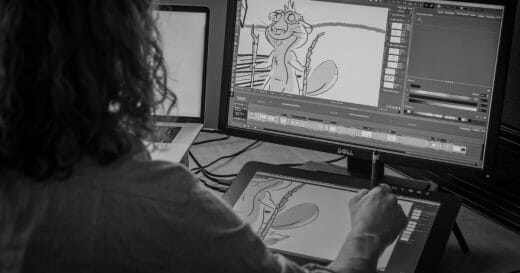
While many animation studios may find the thought of switching from Flash to Toon Boom Harmony daunting, Ludo Studio and 12field Animation’s latest children’s series The Strange Chores proves there’s nothing to be afraid of — and plenty to gain.
With Ludo Studio based in Brisbane and 12field Animation in Melbourne, in partnership with Media World Pictures, the Aussie studios are helping to drive an animation boom Down Under. The former is behind the massively popular cartoon Bluey, though it decided to aim at an older audience (8 to 12 years old) with The Strange Chores.
Premiering on October 31, 2019, on ABC ME, the 2D animated paranormal comedy follows two teenage wannabe warriors Charlie and Pierce and their ghostly gal-pal Que as they master the skills needed to replace ageing monster slayer Old Man Helsing. The best way to learn? To do his supernatural chores, of course.
The Strange Chores was created entirely within Australia, with design, boards, animation and picture post done at 12field Animation. Production on the 26 x 11-minute first season of The Strange Chores lasted approximately 95 weeks, from the start of design to storyboarding to the end of animation — including over 5,000 scenes, 400 rigs, 500 props and 3000 background designs.
We spoke to The Strange Change showrunner and creator Daley Pearson of Ludo Studio and director Scott Vanden Bosch from 12field Animation about bringing the series to (after)life as well as their favourite tricks and treats from their first production using Toon Boom Harmony.

Source: Ludo Studio
The Strange Chores interview
The notion of monster hunting as a chore is pretty unique — and contextualizes the fantastical into something most kids can relate to. Where did the inspiration for the series come from?
Daley Pearson: We wanted to create a show the audience would love and relate to, but also find aspirational. It meant we worked really hard to make The Strange Chores a show that was genuinely for our audience. We remembered the shows we loved when we were around 8 to 12 felt like they were made for our older brothers and sisters, which was a key insight — we didn’t want to make a series the audience would think was ‘for kids’. So the characters, tone and comedy was always at the top of our mind throughout development and production.
The shows that we love that have been big concepts like The Strange Chores always had that key bit of relatability. As crazy as The X-Files was, Mulder and Scully still dealt with boring files — bureaucracy. For a younger audience, that bureaucracy is our characters coming of age and learning responsibility through doing chores that are mostly selfless. This also meant that no matter how strange and ridiculous the show gets, our audience and our characters can always be pulled back to something relatable: chores.
So how did you pitch it?
Daley Pearson: Like our pre-school series Bluey, we first pitched The Strange Chores at the Asian Animation Summit with [producers] Colin South from Media World and Chris Rose who was with ABC Children. The industry in Australia was going through growing pains at that time and so The Strange Chores entered development hell for a little while. Hell wasn’t too bad though and we used our time in purgatory to sharpen up our characters, story and series design with Scott [Vanden Bosch]. We genuinely don’t think there are any shows at the moment that feel like Scott’s designs — they’re perfect for our audience, with a brilliant balance of scary, cool and a bit of wonder about them too.

Source: Ludo Studio
Yes, the character designs —especially for the monsters— are very creative. Were there any series or films that inspired the aesthetic?
Scott Vanden Bosch: Daley and I discussed the general look and feel of what we wanted for the series rather than citing particular references. However, films and series from the 70s like Salem’s Lot and The Goonies from the 80s were discussed! We were both keen to capture some of the tone of those films — the power of friendship against the supernatural world of The Strange Chores.
We wanted it to look contemporary, but different to other animated shows — a look and feel that felt artistic, hand drawn and not hard edged. We wanted to create a world that used light creatively and explored different colour palettes for the many varied locations. Tests were done to explore the character line style in an attempt to match the feel of the pencil style backgrounds.
And when it came time for storyboarding, did you use Storyboard Pro?
Scott Vanden Bosch: We used Storyboard Pro for boarding, as we do for all our shows. It is fast to use and easy to make updates/corrections. It was good to have that familiarity there already across the storyboard department, as we adjusted to the new aspects of a Toon Boom pipeline.
I hear this was your first Harmony production. Did you have to do much in-house training in Toon Boom software for your team?
Scott Vanden Bosch: For The Strange Chores, we transitioned the whole 12field studio over from Adobe Flash to Toon Boom Harmony. Apart from our animation director and some of our newer team who had dabbled a little in Toon Boom at school, no one else in our studio had any prior skills in the software.
We were supported by Toon Boom and Film Victoria to bring two certified Toon Boom trainers to Australia from Canada to conduct two intensive rounds of training — one for the design teams and another for the animation teams. Their instruction was incredibly valuable and it was great to be able to offer professional training as part of employment, which also helped our studio manager recruit some really talented young artists ahead of production.
Having the trainers with us as we ramped up into production was a huge asset, as all our questions were relevant to the production. We built on this crucial initial training to develop the project’s unique rigging and animation style to suit both the needs of the show and lift the skills of our existing studio practice.
What Harmony tools and features helped make the production of The Strange Chores more efficient?
Scott Vanden Bosch: We could definitely produce a better result more quickly in animation using Toon Boom, and this was a big advantage — especially for some of our less-experienced crew. We also found creatively you can do more with the Harmony rigs than you can with Flash and it was satisfying to see really well-animated scenes getting the most out of the rigs and deformers.
It was also great to see that we could replicate our pencil-on-paper style, or ‘charcoal’ line-work that was created in Photoshop and we could experiment with different line styles to match the backgrounds. Being our first Toon Boom show, there was a very significant ramp up required — especially in rigging. As a result, the time and budget efficiencies will likely have a much greater impact on subsequent series now that we are up and running!

Source: Ludo Studio
Until The Strange Chores, 12field had only worked in traditional paper with digital scan and paint, and then in Flash, so moving to the Harmony pipeline was a huge transition. Once we had learnt the process and began refining our rigging, we saw the advantages of being able to create the rigs in a very custom way, capable of a lot of movement, acting and expression.
For example, the flexibility of the characters’ limbs allows for faster re-draw and posing, which was a big advantage as we jumped straight into animation. Also, the pegs allowed for posing that didn’t feel stiff. Working with the deformers made it much easier to stay on-model, keep everything in correct proportion and helped with applying good animation practices.
We also found that working with deformers greatly enhanced the drawing skills of the newer members of the team. We incorporated a lot of re-draw on Strange Chores — partly because it’s the show’s style, but also because we like to not only rely on what’s in the rig and to create lots of different facial expressions, emotions, one-offs or particular movements.

Source: Ludo Studio
Having wrapped The Stranger Chores season one, would you use Harmony for your next production?
Scott Vanden Bosch: Yes, we plan to use Toon Boom for our next production. On a large-scale project and over time, the benefits of an increased quality of output would certainly provide an advantage. We also really liked being able to complete almost all of our VFX all in one program — across highlights, tints, lighting and more special effects like floods, fire and slime. This let us review the work-in-progress immediately, and work back with the animation team.
For our readers not from Down Under, what’s the 2D animation industry like in Australia?
Scott Vanden Bosch: Australia has had a strong 2D animation industry for over 40 years, beginning with Hanna-Barbera and Disney Studios establishing satellite studios here in the early 1970s through to the mid 2000s. Since then, a number of 2D studios have emerged and continue to expand throughout Australia, serving the commercial, television and games industries.
With an ever-increasing talent pool of designers, animators and production personnel, many studios have continued to grow to service the Australian and overseas marketplace. With greater emphasis on co-productions and sharing IP, keeping pace with technology and production methodology is gaining greater focus and importance by the whole Australian industry. Toon Boom leads the way in making this happen.
Interested in switching from Flash to Toon Boom Harmony? Download your 21-day free trial now!
Banner image source: Ludo Studio

